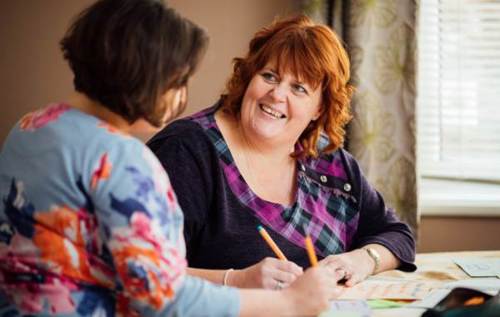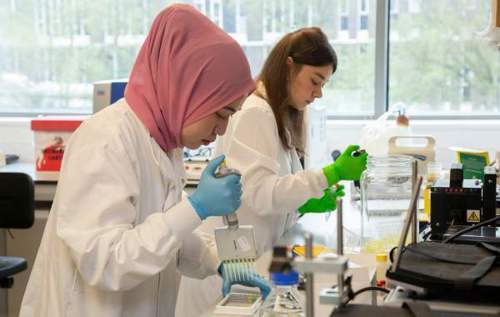What is patient and public involvement and engagement (PPIE) and how does it benefit arthritis research?
06 December 2023
Our researchers are working tirelessly to find better treatments, therapies and, hopefully, cures for arthritis. And we want to make sure we’re working alongside people with arthritis, every step of the way.
In research, this is sometimes called Patient and Public Involvement and Engagement (or PPIE).
What does Patient and Public Involvement and Engagement (PPIE) mean to our research centres?
 We have invested over £50m in 13 research centres of excellence across the UK.
We have invested over £50m in 13 research centres of excellence across the UK.
Centres are a collection of universities and researchers across the UK working collaboratively. This allows them to share resources and ideas, which can lead to great research outcomes.
Involving people with arthritis is vital to our centres’ work. That’s why two centres recently published papers stressing the importance of Patient and Public Involvement and Engagement (PPIE).
To find out more, we spoke to:
- Freya Luling Feilding, CLUSTER Consortium Research Coordinator
- Dr Marie Falahee, Lecturer in Behavioural Rheumatology at Institute of Inflammation and Ageing, University of Birmingham who leads the Birmingham Rheumatology Research Patient Partnership.
In the CLUSTER study, Freya and her team wanted to involve people who live with juvenile idiopathic arthritis (JIA) or are parents/carers of those with JIA, to help shape studies by researchers early in their career.
Marie and her team focused on making a ’Student Patient Alliance’, where PhD students worked with patients to include them in their research.
What is Patient and Public Involvement and Engagement (PPIE)?

“In our view, PPIE is about putting patients front and centre of research,” explains Freya. “It’s often referred to as research that’s carried out ‘with’ or ‘by’ patients or members of the public rather than ‘to’ or ‘about’ them.”
As well as being a researcher, Marie also lives with inflammatory arthritis. “As both a researcher and a patient, I firmly believe that the experiences of patients and members of the public can meaningfully improve the quality of research,” she says.
“[They] can contribute and help us decide what research should be done, how it should be carried out, and how the findings should be shared with the public.”
“It was great talking to researchers. They were very interested in understanding what it’s like living with the condition and being a parent of a child with the condition as well. They came away realising how and why it’s so important to have PPIE in their research from the beginning.”
“It’s important because it gives researchers motivation on the tiring days as they can remember who they are doing it for and how many lives they can improve."
What are the benefits of Patient and Public Involvement and Engagement (PPIE)?
 PPIE is a win-win for both researchers and patients alike.
PPIE is a win-win for both researchers and patients alike.
It gives the public a say in the research we do, and it helps researchers understand the realities of living with arthritis, so they can make sure their research is relevant.
“It’s about ensuring that our research is the ‘right’ kind of research,” explains Freya. “That it solves an unmet need that people with arthritis have told us, rather than what academics see as a ‘gap’.”
“Patients and families not only benefit from the research outcomes themselves, but it also offers them a sense of empowerment.
“It also helps to demystify research, which can sometimes feel inaccessible to patients and the public.”
For this reason, Freya and her team have been working closely with a group of people living with juvenile idiopathic arthritis, their parents, as well as charity partners. They call them CLUSTER champions.
"If researchers don’t have experience living with JIA or knowing someone who does live with it, then it creates a disconnect... We are the people who live with it every day. We have tons of valuable input to give. Researchers have the ability to make great change in peoples’ lives and I think they should see that firsthand.”
Marie says that people with arthritis have “valuable expertise that can help research in many ways.”
She says that PPIE helps ensure that research is:
- relevant to patients’ needs
- designed in a way that is ethical and efficient
- and communicated in a way that reaches a broad audience and is more likely to make a difference for those it is intended to help.
“Learning about patients’ experiences of living with a musculoskeletal condition [improves] their motivation, and their ability to describe their research to members of the public.”
[Pull quote] “It kept my focus... Being basic science researchers, we’re really focused on getting the right research design, having the right experiments, testing everything at a very molecular level and I think we tend to forget that the only reason that we’re doing this is to actually improve patients’ lives.”
What are the challenges of Patient and Public Involvement and Engagement?
PPIE isn’t always easy — and it can take a lot of work behind the scenes to bring it to life. Marie says that the “main challenge of PPIE is making sure that it’s meaningful rather than tokenistic.”
“Researchers may not have the right skills or knowledge to be able to create the conditions where the public feel they are able to make a real difference to research."
She says they need to be able to:
- communicate in a way that is easy to understand.
- identify research activities that patient partners can actively get involved in.
- have the time and resources to make this happen in a way that members of the public feel they are valued partners.
"This can be especially challenging for research that is very technical or laboratory based.”
Freya says that early career researchers found PPIE challenging for several reasons, such as:
- Knowing who to talk to first to make PPIE happen.
- Organising events.
- How to reach out to patients and parents who aren’t usually involved in research to encourage diversity.
- Practical challenges, such as fundraising, time commitments and privacy concerns.
What did your study hope to achieve? What were your findings?
Developing and implementing ‘A guide to PPIE’
Freya and her team wanted to create “practical guidance for researchers to follow to involve patient and parent partners in their research.”
“We aimed to make sure PPIE was meaningful and not only a tick box on grant application forms. So, we co-designed this process with our dedicated Patient and Parent group (the CLUSTER Champions) and with input from our researchers.
“In our study, we describe our successful approach to PPIE, setting out a step-by-step process to support involvement at the earliest possible stage of designing a study.”
“Involving [patients] has both ensured that the projects I propose are meaningful to those it is designed for and has allowed me to give agency to young people and their families in planning research that matters to them”
Developing and evaluating a Student Patient Alliance (SPA)
Meanwhile, Marie’s team wanted to train researchers in PPIE in the early steps of their careers.
“One way of achieving this is to embed PPIE into the research carried out by PhD students, so we set up the Student Patient Alliance (SPA),” says Marie.
“The alliance partners patients with research students, supported by our Versus Arthritis funded centres of excellence. Most of [these] were carrying out laboratory-based research projects.”
Patients also helped to select which projects were prioritised by the centre.
“Students felt that discussing their research with patient partners improved their own understanding of the research area, as well as their understanding of the disease. Students also worked with their patient partners to produce some fantastic public engagement activities, such as plain English summaries of research which were published online, award winning poster presentations and joint presentations at patient group meetings
“However, we also highlighted that appropriate resources are needed... for this to work on a larger scale."
How did people with arthritis get involved in your research?
At the Student Patient Alliance, Marie says “each student was assigned a patient research partner and provided with some information about PPIE, training opportunities, and suggestions for activities they could work on together.”
“Students were asked to keep a record of any activities they involved their patient partner in. Both students and patient partners provided regular feedback on their experiences of working together.”
Freya says that her team have a dedicated group of patients and parents who have been “core partners from the beginning.” They are called CLUSTER Champions.
“These are individuals who have personal ties to Juvenile Idiopathic Arthritis and uveitis, an associated eye conditions typically being patients or parents (or in some cases, both).”
What tips or advice would you give to researchers who want to practice Patient and Public Involvement and Engagement (PPIE)?
“I would encourage them to think about ways in which members of the public can make a meaningful difference to their research and identify specific questions they can ask patient partners for feedback on,” says Marie. “That way everyone involved feels that PPIE is making a valuable difference.”
Meanwhile, Freya’s words of wisdom are to “start early.”
“The earlier you can involve patients or parents in your research process, the better,” she says. “Also, always remember to give feedback to PPIE representatives about the progress of your research. We know from experience that this is so important to encourage future engagement. Patients and families love to hear about the results and progress.”
Dr Marie Falahee, Lecturer in Behavioural Rheumatology at the Institute of Inflammation and Ageing, University of Birmingham, is senior author on the paper: The student patient alliance: development and formative evaluation of an initiative to support collaborations between patient and public involvement partners and doctoral students (springer.com).
The work contributing to this paper was supported by our Research Into Inflammatory Arthritis Centre (RACE) and Centre for Musculoskeletal Ageing Research (CMAR, which is partner funded by Versus Arthritis with the UKRI MRC).
Dr Freya Luling Feilding, CLUSTER Consortium Research Coordinator, is a joint lead author on: Development and implementation of ‘A guide to PPIE – Early Integration into Research Proposals’ in a multi-disciplinary consortium | Rheumatology | Oxford Academic (oup.com).
This publication was supported by CLUSTER (CLUSTER is funded by the UKRI MRC, Versus Arthritis, Children’s Charity and Olivia’s Vision) the associated Centre for Adolescent Rheumatology (partner funded by Versus Arthritis with Great Ormond Street Hospital Children’s Charity) and the NIHR Biomedical research Centre at Great Ormond Street Hospital.